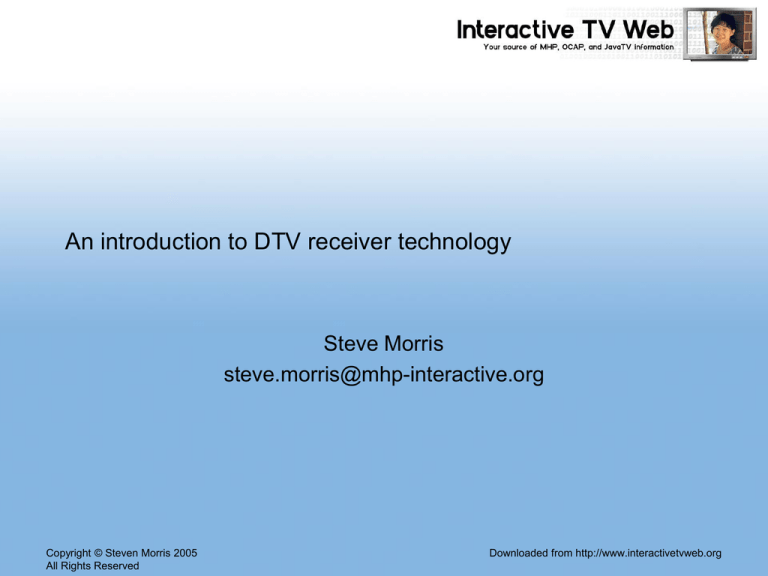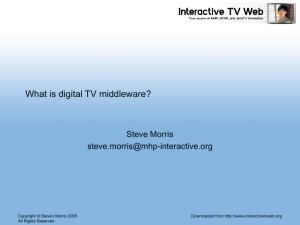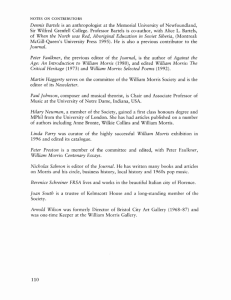
An introduction to DTV receiver technology
Steve Morris
steve.morris@mhp-interactive.org
Copyright © Steven Morris 2005
All Rights Reserved
Downloaded from http://www.interactivetvweb.org
What does a DTV receiver do?
• Receives digital TV broadcasts from a cable, satellite or terrestrial
network
• Decodes them
• Outputs them to a television or other display device
– This display device is usually a television
• May do other things
– E.g. execute applications included with the broadcast
Copyright © Steven Morris 2005
All Rights Reserved
Downloaded from http://www.interactivetvweb.org
Types of digital TV receiver
• Set-top box (STB)
– The most common type
– Varies in functionality and features from very basic to very advanced
– May be integrated with other types of device
• E.g. a DVD player or PVR system
• Integrated Digital TV (IDTV)
– Receiver is built into a TV set
– Can receive digital or analog broadcasts with no extra hardware
• PC with digital tuner card
– Similar to analog TV tuners, except it decodes digital TV signals
Copyright © Steven Morris 2005
All Rights Reserved
Downloaded from http://www.interactivetvweb.org
Block diagram of a typical receiver
Tuner
Front-end
Smart card /
CA Module
Descrambler
MPEG-2
demultiplexer
MPEG-2
decoder
SDRAM
Graphics
processor
CPU
Middleware
Copyright © Steven Morris 2005
All Rights Reserved
Flash memory
Downloaded from http://www.interactivetvweb.org
The Front End
• The part of the receiver that actually receives the analog signal and
converts it into a stream of bits
–
–
–
–
Two main components, the tuner and the front end
These may be integrated into a single package
Usually specific to cable, satellite or terrestrial networks
Some may support both analog and digital signals
• The tuner
– Receives a signal on the frequency specified by the rest of the STB
– Demodulates the signal
– Turns the analog signal into a digital bitstream
• The front-end
– Performs first level of error correction
– Removes the first level of packetization in the stream
– Outputs an MPEG-2 transport stream in digital format
Copyright © Steven Morris 2005
All Rights Reserved
Downloaded from http://www.interactivetvweb.org
The Demultiplexer
• Takes an MPEG-2 transport stream and locates those elements that
the STB is interested in
– All elements of the current channel
• Audio and video streams
• Broadcast data streams
• Service information
– Some service information for the network as a whole
• Passes these streams on to other parts of the system
– Service information and data streams to the CPU (if it is interested)
– Audio and video to the MPEG decoder
• Other data from the transport stream is thrown away
– But demultiplexer may include section filtering capability to filter other MPEG-2
sections as requested by applications
Copyright © Steven Morris 2005
All Rights Reserved
Downloaded from http://www.interactivetvweb.org
The MPEG Decoder
• Decodes audio and video streams and displays them on the screen
• May include support for graphical overlays
– Cursor, graphics
– Some receivers support up to five graphics planes
• Background, video, two graphics planes, cursor
• May include support for scaling, clipping and repositioning video
– But this may be limited
• Typically combined with the graphics processor
– Makes it easier to integrate different elements of the display
Copyright © Steven Morris 2005
All Rights Reserved
Downloaded from http://www.interactivetvweb.org
The CPU
• Handles all of the other tasks in the system
–
–
–
–
Decoding and handling service information
Decoding broadcast data streams
User interaction
Running built-in or downloaded applications
• Often integrated with the MPEG-2 decoder and other components
• Typical CPUs
–
–
–
–
STMicroelectronics 551x family
NEC EMMA2
ATI Xilleon
Broadcom BCM3560
Copyright © Steven Morris 2005
All Rights Reserved
Downloaded from http://www.interactivetvweb.org
Conditional access (CA)
• Anti-piracy system for pay-TV
– Decrypts some or all of the data
• Depending what was encrypted by the network operator
– Usually based around some kind of physical token
• Smart card or similar device
• Only that token will work with that receiver
• Each STB usually has one CA system integrated
– This is enough for most pay-TV systems
– The box is tied with the subscription, so only used on one network and one CA
system
• Most common CA vendors:
–
–
–
–
–
NDS (VideoGuard)
Nagravision-Kudelski (Nagravision)
Conax (Conax)
Motorola
France Telecom (Viacess)
Copyright © Steven Morris 2005
All Rights Reserved
–
–
–
–
Canal + (MediaGuard)
Philips (Cryptoworks)
Irdeto (IrdetoAccess)
General Instrument (DigiCypher II)
Downloaded from http://www.interactivetvweb.org
Conditional Access (CA)
• Some CA systems require special hardware support
– e.g. NDS
– Usually features built into the CPU
– Most systems will use a standard Smart Card slot
• Some receivers will use two, one for CA and one for banking card, etc.
• Some network operators are now using pure software CA systems
– No need for extra hardware module
– Makes it quicker to roll out new encryption when the old one is cracked
– May still use smart cards for authentication
• CA systems may do more than just encryption
– Pair a smart card to a single receiver
• Smart card can not be moved to other receivers
– Provide a way of uniquely identifying the receiver
• Smart card serial number
– Prevent STBs moving to other household
• Second STB usually provided at lower price by network operator
• CA system may stop that box being given to neighbor, friend, other family member
• Every household must have their own subscription
Copyright © Steven Morris 2005
All Rights Reserved
Downloaded from http://www.interactivetvweb.org
Conditional Access (CA)
• Integrated CA systems are unsuitable for some markets
• May use a pluggable CA module instead
–
–
–
–
Entire decryption solution on a PCMCIA card
Smart card plugs in to PCMCIA card
Used on retail systems to allow use with any network
Common systems include:
• DVB Common Interface (DVB-CI)
• ATSC Point Of Deployment (POD) module
• OpenCable CableCARD (based on POD)
• This has several limitations
– More expensive (PCMCIA card vs. integrated smart card reader)
– Very few vertical markets will use pluggable CA modules because there is no
need or benefit
– Also perceived as being less secure, in the case of DVB-CI
• Not all CA systems will support pluggable modules
Copyright © Steven Morris 2005
All Rights Reserved
Downloaded from http://www.interactivetvweb.org
Return channel
• Used to communicate with the network operator or other service
operator
– Ordering pay-per-view services, home shopping, home banking
• May be used for general network access
– Web browsing, email, chat
• Many types in use
– PSTN modem (usually 56K) is still the most common
– Cable modem and ADSL modem are becoming more common
– Exotic technologies such as GSM, DVB RCS (return channel via satellite) etc.
also in limited use
• Not every receiver will have a return channel
– Adds to the cost
– Not all subscription services will need or use one
Copyright © Steven Morris 2005
All Rights Reserved
Downloaded from http://www.interactivetvweb.org
Middleware
• Provides a common software platform for application development
– Usually in C or Java
– Every middleware platform has basically the same features
• Graphics & video manipulation, return channel access, access to service information,
etc.
• Most middleware platforms today are proprietary
–
–
–
–
–
–
–
OpenTV (OpenTV Core)
NDS (NDS Core)
Canal+ (MediaHighway)
PowerTV (PowerTV)
Microsoft (Microsoft TV)
Nagravision-Kudelski (Tsunami)
Liberate (Liberate)
• But open middleware platforms are now being deployed
– MHP, OCAP, ACAP, JavaTV, ARIB-B23
Copyright © Steven Morris 2005
All Rights Reserved
Downloaded from http://www.interactivetvweb.org
Integration
• Cost is a major factor in STB manufacture
–
–
–
–
Especially in vertical markets
Everyone wants the product cheaper
Lots of competition
Typical cost is ~100 USD to the network operator for a standard STB
• Retail is more expensive
• Many components get integrated to save cost
– Tuner and front end
– Demultiplexer/MPEG decoder/CPU/graphics processor
• Most current STBs are one- or two-chip solutions
– Depends on features needed
• Pressure is always towards more integrated solutions
Copyright © Steven Morris 2005
All Rights Reserved
Downloaded from http://www.interactivetvweb.org
Block diagram of a typical receiver
Tuner
Front-end
Descrambler
MPEG-2
demultiplexer
Standard STB with pay-TV
support (integrated)
BOM Cost: ~80 USD
Integrated into front-end
MPEG-2
decoder
SDRAM
Graphics
processor
CPU
Integrated into CPU
Middleware
Copyright © Steven Morris 2005
All Rights Reserved
Smart card /
CA Module
Flash memory
Downloaded from http://www.interactivetvweb.org
Three distinguishing features
• To use a receiver on a given network, we care about three things:
– Middleware
• The APIs used to develop interactive applications
– Conditional access system
• The type of encryption used to protect pay-TV content
– Type of network it receives the signal from
• Terrestrial, cable or satellite
• Does it use ATSC, OpenCable, or DVB standards?
• These determine whether a receiver will work on a that network
– Other specifications are less important
– All of these features will be determined by the network operator in a vertical
market
Copyright © Steven Morris 2005
All Rights Reserved
Downloaded from http://www.interactivetvweb.org
Receiver markets
• Two types of market for digital TV receivers
– Horizontal market (receivers sold in retail stores)
• Free-to-air networks
• Some cable networks in the USA
– Vertical market (receivers supplied by network operators)
• Pay-TV networks in Europe and Asia
• Some Pay-TV networks in the USA
• These markets have very different business models
– Thus, the pressures on the receiver manufacturer and on the spec of the
receiver are also different
– Which market type is best for a given manufacturer depends on their skills and
strengths
– Neither type of market will go away
• Both will likely grow in the short term
• Becoming more common with more digital terrestrial TV
deployments and the use of open standards for middleware
Copyright © Steven Morris 2005
All Rights Reserved
Downloaded from http://www.interactivetvweb.org
Horizontal markets
• Receivers are sold through retailers
– E.g. electronics store, supermarket
• Often used for free-to-air channels only
– Especially in Europe and Asia
– No subscriptions needed
• User may be able to buy subscription from pay-TV company
– Some US cable networks
– Provides access to pay-TV channels as well as free-to-air channels
– Uses a pluggable CA module to ensure receiver works on all networks
• But not every receiver in every horizontal market will include this!
– More choice for the user
– More scope for different types of receiver
– Means the network operator doesn’t have to own the boxes
• Less capital investment
Copyright © Steven Morris 2005
All Rights Reserved
Downloaded from http://www.interactivetvweb.org
Vertical markets
• Boxes are bought by the network operator and supplied to
customers
– Either rented or as part of subscription package
• The main model for pay-TV systems at the moment
– Especially in Europe & Asia
– Usually used by pay-TV satellite or cable networks
• Gives the network operator more control over their network
– Network operator defines the hardware and software specification for the boxes
– May still be supplied by more than one vendor
– Gets better price because of volume discounts and guaranteed order numbers
• But has the costs associated with owning all of the receivers
– Large capital investment
– More support needed
• Logistics, tech support, installation, repair, etc.
Copyright © Steven Morris 2005
All Rights Reserved
Downloaded from http://www.interactivetvweb.org
Classes of receiver
• Different groups have different needs from an STB
–
–
–
–
Some people want something cheap
Most people want an average box that lets them do a little bit more
Some people will pay extra for more advanced features
A few want to add DTV support to their PC
• Products are available for most of these groups
– But some groups don’t have much choice
• Pay-TV operators will only support a few types of product
– Supporting more is expensive
– Typically will only provide an average box with some support for interactivity
– May provide a more advanced box (as part of a more expensive subscription)
• Retail products have wider range of features and prices
Copyright © Steven Morris 2005
All Rights Reserved
Downloaded from http://www.interactivetvweb.org
Classes of receiver – Basic ‘zapper’
• Very basic hardware
– Limited memory and CPU power, no return channel
• Usually sold retail
• Can receive free channels only
– No support for subscription or pay-per-view channels
• Simple features
–
–
–
–
–
Channel up/down
Control audio language
Control subtitles
No program guide or other features
No interactivity
Copyright © Steven Morris 2005
All Rights Reserved
Downloaded from http://www.interactivetvweb.org
Block diagram of a basic receiver
Tuner /
Front-end
Free-to-Air ‘zapper’ box
BOM Cost: ~30-40 USD
MPEG-2
demultiplexer
SDRAM
SDRAM
MPEG-2
decoder
μController
Copyright © Steven Morris 2005
All Rights Reserved
ROM
Downloaded from http://www.interactivetvweb.org
Classes of receiver - Standard
• Slightly more advanced STB
– More memory, faster CPU, maybe a return channel
• Usually sold retail or as part of a subscription
• May receive some pay-TV channels
– Usually tied to a specific network in subscription systems
– May include support for pluggable CA module in retail products
• Some interactivity
– Program guide
– Maybe games or features associated with a specific show
– Maybe other interactive services offered by the network operator
Copyright © Steven Morris 2005
All Rights Reserved
Downloaded from http://www.interactivetvweb.org
Classes of receiver - Advanced
• Advanced features
– More memory, faster return channel, extra hardware (e.g. keyboard)
• Usually sold retail or as part of an advanced subscription package
• Receives some pay-TV channels
– As for standard STB
• Integrates other features
– E.g. PVR
• May include more interactive features
– More applications, e.g. web browser or email
– Makes use of improved hardware to offer more services
Copyright © Steven Morris 2005
All Rights Reserved
Downloaded from http://www.interactivetvweb.org
Classes of receiver – Very advanced
• Typically a PC with digital tuner card
– Either internal or external
• May not be able to receive pay-TV channels
– Piracy concerns may prevent this
• May include many advanced features
– PVR, web browsing, email, DVD playback
– All PC applications
– But the actual DTV functionality may also be very limited
• Not usually the main device in a home
– Typically will not replace the TV/STB combination in the living room
• except in a very small urban home
– May be used in a young person’s bedroom or university accommodation
• Combination device to save space
Copyright © Steven Morris 2005
All Rights Reserved
Downloaded from http://www.interactivetvweb.org
Conclusion
• All DTV receivers are fairly similar
– Most differences are in the software
• E.g. middleware, CA system
• Feature sets range from extremely basic to very advanced
– But most boxes currently sold will have roughly the same features
• Middleware to provide some interactive applications (e.g. program guide and
downloaded apps)
• PSTN modem or cable modem for return channel
• The move towards horizontal markets is giving more opportunities
for receiver manufacturers
– Markets are growing
– Wider range of feature sets can be sold
• As markets grow, more televisions will include this functionality
– Just like TVs now include cable as well as terrestrial reception
Copyright © Steven Morris 2005
All Rights Reserved
Downloaded from http://www.interactivetvweb.org








